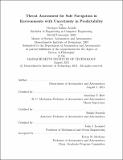Threat assessment for safe navigation in environments with uncertainty in predictability
Author(s)
Aoudé, Georges Salim
DownloadFull printable version (11.61Mb)
Other Contributors
Massachusetts Institute of Technology. Dept. of Aeronautics and Astronautics.
Advisor
Jonathan P. How.
Terms of use
Metadata
Show full item recordAbstract
This thesis develops threat assessment algorithms to improve the safety of the decision making of autonomous and human-operated vehicles navigating in dynamic and uncertain environments, where the source of uncertainty is in the predictability of the nearby vehicles' future trajectories. The first part of the thesis introduces two classes of algorithms to classify drivers behaviors at roads intersections based on Support Vector Machines (SVM) and Hidden Markov Models (HMM). These algorithms are successfully validated using a large real-world intersection dataset, and can be used as part of future driver assistance systems. They are also compared to three popular traditional methods, and the results show significant and consistent improvements with the developed algorithms. The second part of the thesis presents an efficient trajectory prediction algorithm that has been developed to improve the performance of future collision avoidance and detection systems. The proposed approach, RR-GP, combines the Rapidly-exploring Random Trees (RRT) based algorithm, RRT-Reach, with mixtures of Gaussian Processes (GP) to compute dynamically feasible paths, in real-time, while embedding the flexibility of GP's nonparametric Bayesian model. RR-GP efficiently approximates the reachability sets of surrounding vehicles, and is shown in simulation and on naturalistic data to improve the performance over two standard GP-based algorithms. The third part introduces new path planning algorithms that build upon the tools that have been previously introduced in this thesis. The focus is on safe autonomous navigation in the presence of other vehicles with uncertain motion patterns. First, it presents a new threat assessment module (TAM) that combines the RRT-Reach algorithm with an SVM-based intention predictor, to develop a threat-aware path planner. The strengths of this approach are demonstrated through simulation and experiments performed in the MIT RAVEN testbed. Second, another novel path planning technique is developed by integrating the RR-GP trajectory prediction algorithm with a state-of-the-art chance-constrained RRT planner. This framework provides several theoretical guarantees on the probabilistic satisfaction of collision avoidance constraints. Extensive simulation results show that the resulting approach can be used in real-time to efficiently and accurately execute safe paths. The last part of the thesis considers the decision-making problem for a human-driven vehicle crossing a road intersection in the presence of other, potentially errant, drivers. The proposed approach uses the TAM framework to compute the threat level in real-time, and provides the driver with a warning signal and the best escape maneuver through the intersection. Experimental results with small autonomous and human-driven vehicles in the RAVEN testbed demonstrate that this approach can be successfully used in real-time to minimize the risk of collision in urban-like environments.
Description
Thesis (Ph. D.)--Massachusetts Institute of Technology, Dept. of Aeronautics and Astronautics, 2011. Cataloged from PDF version of thesis. Includes bibliographical references (p. 213-224).
Date issued
2011Department
Massachusetts Institute of Technology. Department of Aeronautics and AstronauticsPublisher
Massachusetts Institute of Technology
Keywords
Aeronautics and Astronautics.